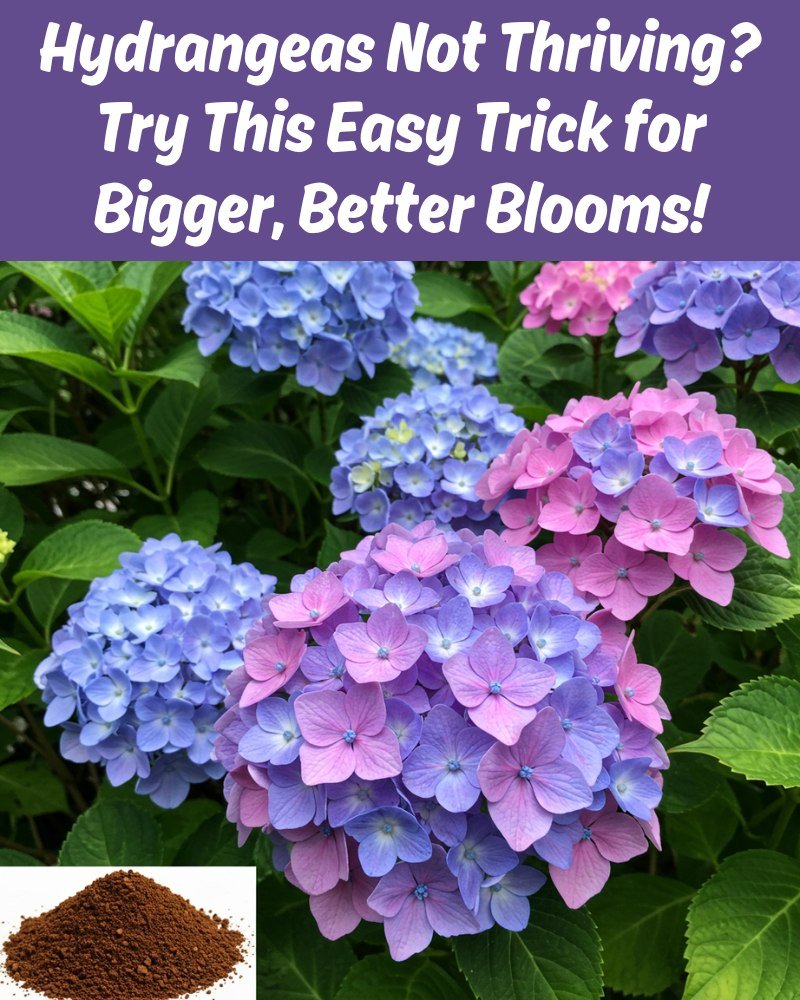Hydrangeas are one of the most beloved garden shrubs, known for their stunning, voluminous blooms that can transform any landscape into a picturesque paradise. However, despite their popularity, many gardeners struggle to get their hydrangeas to thrive. If your hydrangeas are looking lackluster, with small blooms or sparse foliage, don’t despair! There’s an easy trick that can help you achieve bigger, better blooms and healthier plants. Let’s dive into the secrets of growing thriving hydrangeas.
Why Aren’t My Hydrangeas Thriving?
Before we reveal the trick, it’s important to understand why your hydrangeas might not be performing at their best. Common issues include:
- Improper Soil pH: Hydrangeas are unique in that their bloom color can change based on soil acidity or alkalinity. If the pH is off, it can affect nutrient uptake and overall plant health.
- Inadequate Watering: Hydrangeas are thirsty plants and require consistent moisture, especially during hot, dry periods.
- Poor Soil Quality: These plants thrive in rich, well-draining soil. Compacted or nutrient-deficient soil can stunt growth.
- Incorrect Pruning: Pruning at the wrong time or too aggressively can remove the buds that would have produced blooms.
- Lack of Sunlight: While hydrangeas prefer partial shade, too little sunlight can result in fewer blooms.
If you’ve addressed these common issues and your hydrangeas still aren’t thriving, it’s time to try the easy trick that can make all the difference.
The Easy Trick: Coffee Grounds for Hydrangeas
Yes, you read that right—coffee grounds! This simple, natural remedy can work wonders for your hydrangeas. Here’s why:
1. Coffee Grounds Improve Soil Acidity
Hydrangeas, especially the popular Hydrangea macrophylla varieties, thrive in slightly acidic soil (pH 5.5 to 6.5). Coffee grounds are naturally acidic and can help lower the soil pH, creating the ideal environment for your hydrangeas to absorb nutrients and produce vibrant blooms.
2. They Add Essential Nutrients
Coffee grounds are rich in nitrogen, a key nutrient that promotes healthy foliage and strong stems. They also contain trace amounts of potassium and phosphorus, which support root development and flower production.
3. Coffee Grounds Enhance Soil Structure
When worked into the soil, coffee grounds improve its texture, making it more porous and better at retaining moisture. This is especially beneficial for hydrangeas, which need consistent hydration.
How to Use Coffee Grounds for Hydrangeas
Using coffee grounds is simple, but it’s important to do it correctly to avoid over-acidifying the soil or creating a moldy mess. Follow these steps:
- Collect Used Coffee Grounds: Save your used coffee grounds after brewing. You can also ask local coffee shops for their leftovers—they often give them away for free!
- Dry the Grounds: Spread the coffee grounds on a baking sheet or newspaper and let them dry completely. This prevents them from clumping and reduces the risk of mold.
- Apply to the Soil:
- Option 1: Sprinkle a thin layer of dried coffee grounds around the base of your hydrangea plant, avoiding direct contact with the stems. Gently work them into the top inch of soil.
- Option 2: Mix the coffee grounds into your compost pile and apply the compost around your hydrangeas for a nutrient-rich boost.
- Water Thoroughly: After applying the coffee grounds, water the area well to help the nutrients seep into the soil.
- Repeat Monthly: For best results, apply coffee grounds once a month during the growing season (spring through early fall).
Additional Tips for Thriving Hydrangeas
While coffee grounds can work wonders, they’re just one piece of the puzzle. Here are a few more tips to ensure your hydrangeas thrive:
- Test Your Soil pH: Use a soil test kit to determine your soil’s pH. If it’s too alkaline, coffee grounds can help. If it’s too acidic, you may need to add lime to balance it.
- Water Consistently: Hydrangeas need about 1 inch of water per week. Use a soaker hose or drip irrigation to keep the soil evenly moist.
- Mulch Around the Base: Apply a 2-3 inch layer of organic mulch (like wood chips or shredded leaves) around your hydrangeas to retain moisture and regulate soil temperature.
- Prune Correctly: Research your specific hydrangea variety to determine the best time to prune. Some hydrangeas bloom on old wood, while others bloom on new growth.
- Fertilize Wisely: Use a balanced, slow-release fertilizer in early spring to support healthy growth and abundant blooms.
The Results: Bigger, Better Blooms
By incorporating coffee grounds into your hydrangea care routine, you’ll likely notice a significant improvement in your plants’ health and bloom size. The increased acidity and added nutrients will encourage lush foliage and larger, more vibrant flowers. Plus, you’ll be recycling a common household waste product—talk about a win-win!
Final Thoughts
Hydrangeas are a stunning addition to any garden, but they do require a bit of TLC to reach their full potential. If your hydrangeas aren’t thriving, don’t give up—try the coffee grounds trick and watch your plants transform. With the right care, you’ll be rewarded with breathtaking blooms that will make your garden the envy of the neighborhood.
So, grab your coffee grounds, head out to the garden, and give your hydrangeas the boost they deserve. Happy gardening!



